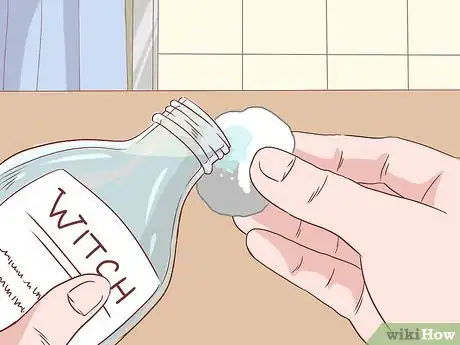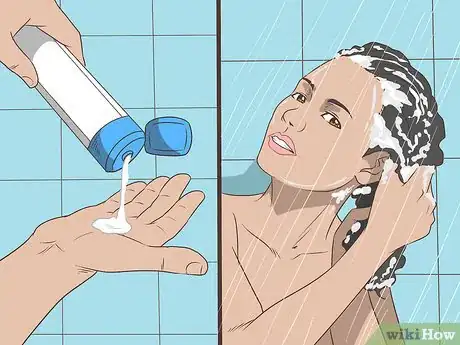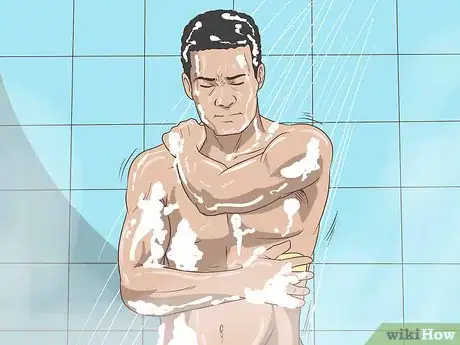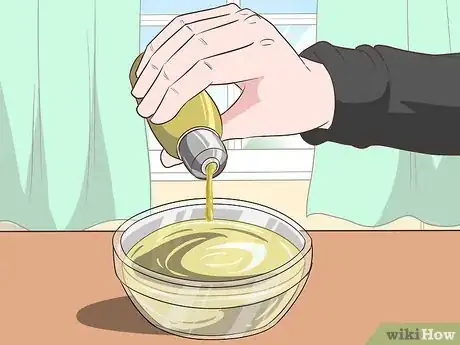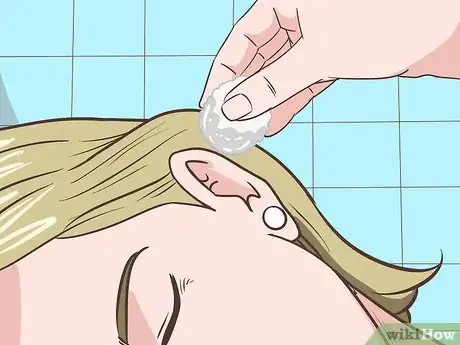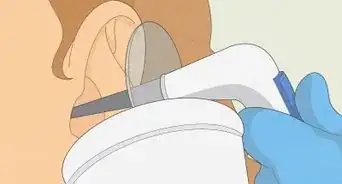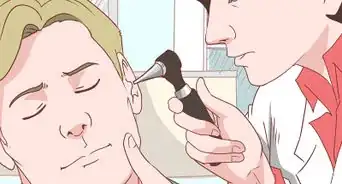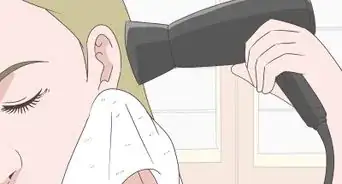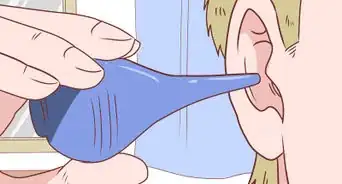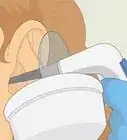This article was co-authored by Monica Kieu, DO, FACS. Dr. Monica Kieu is a board certified Otolaryngologist and Specialist in Facial Plastic and Reconstructive Surgery in Los Angeles, California. Dr. Kieu received a BS in Anthropology from the University of California, Riverside and earned her medical degree (DO), with honors, from Western University of Health Sciences in Pomona. She then completed her residency in Otolaryngology-Head and Neck Surgery at Michigan State University/Detroit Medical Center, where she served as chief resident. Dr. Kieu also completed a prestigious fellowship in Facial Plastic and Reconstructive Surgery at the University of Toronto. She is a member of the American Academy of Otolaryngology-Head and Neck Surgery, American Osteopathic Colleges of Ophthalmology and Otolaryngology-Head and Neck Surgery, American Academy of Cosmetic Surgery, American Academy of Facial Plastic and Reconstructive Surgery, and the American Rhinologic Society. Dr. Kieu was recently named one of LA’s Top Docs by Los Angeles Magazine.
This article has been viewed 62,112 times.
You might not think about it often, but washing behind your ears is an important part of staying clean. Washing prevents waxy deposits from building up and crusting behind your ears, and keeps oils from your hairline from causing clogged pores. Make cleaning back there part of your regular health and beauty process. Cleaning behind your ears is as easy as choosing the right cleansing product, incorporating it into your shower routine, or using cotton swabs to get those hard-to-reach areas.
Steps
Choosing a Cleanser
-
1Select an appropriate cleanser for your skin type. Most people can simply use regular soap – whatever you wash your body with in the shower – to clean behind their ears.[1] If you have sensitive skin, use a gentle foaming cleanser like a product you would use on your face.
- Use a cleanser that you’re familiar with – if it’s comfortable on your body or face, it probably won’t irritate the skin behind your ears.
-
2Use acne wash if you have blackheads. Some people are prone to getting acne outside and behind their ears. This can be due to oils from the hairline clogging pores. Wash with a mild acne wash if you’re prone to getting blackheads behind your ears.
- After you clean behind your ears, dab some rubbing alcohol on the affected area with a cotton swab. This can help to kill bacteria that live there and cause acne.
Advertisement -
3Wash with shampoo for added convenience. Use shampoo to wash behind your ears while you're in the shower. This is a good option if you often forget to clean behind your ears – it’s easy to remember to do while you’re shampooing your hair. Work up a good lather and use the sudsy foam to clean back there.
- Be sure to rinse it off thoroughly – shampoo can easily get stuck behind your ear.[2]
-
4Use gentle products for children’s ears. Parents should clean behind their children’s ears regularly. Be sure to use a cleansing product that is safe and effective for kids.[3] Use your child’s tear-free shampoo or a baby-safe soap or cleanser.
- Babies have especially sensitive skin, so avoid using harsh soap on them.
Washing With Warm Water
-
1Soap up some warm water in the shower. Stand in the shower under a stream of warm water. Lather up some of your cleanser in your hands so you get a good foam. Make sure the water is warm, but not hot enough to burn your skin.
- Instead of showering, you can also wash your ears while leaning over your bathroom sink.[4]
-
2Gently scrub with a clean cloth. Lather up a clean washcloth with your soap suds. Gently scrub the skin behind your ears.[5] It may help to use one hand to pull your ear forward (gently!) so you have more space to clean back there.
- If you have sensitive skin, try just lathering up the area with your fingertips. A cloth may be too rough for you.
-
3Rinse thoroughly. Stand under the warm water or splash warm water onto the area to clean it. Make sure you rinse all the soap off – leaving soap suds behind your ear may irritate your skin or cause crusting.
-
4Dry the area well. Use a clean, soft towel to thoroughly dry the skin behind your ear.[6] Pat the area dry - don’t scrub it. Dry inside any folds of skin back there, and don’t be afraid to gently pull your ear forward to access that small space.
- If you blowdry your hair, you can also dry behind your ear with the hair dryer on a cool setting.
-
5Give the area a wipe with tea tree oil. Put a drop of tea tree oil on a cotton ball. Gently wipe the area behind your ear that you just cleaned. This can help to remove any leftover soap residue.[7]
- You can get tea tree oil at most drug stores, pharmacies, or some health food stores.
- If using tea tree oil causes redness, itching, or pain, stop using it right away. Tea tree oil may be too harsh for sensitive skin.[8]
Cleaning With a Cotton Swab
-
1Prepare the cotton swab with your cleanser. Cotton swabs can be very useful to clean small spaces like the area behind your ear. You can also clean behind your child’s ear with cotton swabs – this can be done more regularly and easily than bathing.[9] Select the appropriate cleanser and wet both sides of a clean, fresh cotton swab – use one end for each ear.
-
2Wipe dirt away gently. Whether you’re cleaning your own ears or a child’s ears, be gentle – pulling hard on the ear can cause discomfort. Use small vertical wiping motions to remove any dirt or crust that’s behind the ear. Wipe in a single direction, up or down, to sweep the dirt away. Wipe away any visible debris with a washcloth, another cotton swab, or a cotton ball.
- Be sure to wipe inside any small nooks and crevices on the outside of your ear.[10]
- If the cotton swab dries out, rewet it with your cleanser.
-
3Only use cotton swabs on the outside of the ear. Do NOT put cotton swabs or any other objects inside your ear. Despite being a popular practice, this does not help to remove earwax and can even damage your ears.[11] Reserve cleaning with cotton swabs for outside the ear only, and clean inside your ears with peroxide, oil, or other liquid products.
Warnings
- Healthcare professionals warn that you should never put any objects into your ear, including cotton swabs.[12]⧼thumbs_response⧽
- Stop using any product that causes pain, redness, dryness, or itching.⧼thumbs_response⧽
References
- ↑ http://www.hygieneexpert.co.uk/correct-ear-cleaning.html
- ↑ https://healthpoweredkids.org/lessons/all-about-the-ear/
- ↑ http://www.aboutkidshealth.ca/En/HealthAZ/HealthandWellness/EyeandEarCare/Pages/how-to-clean-ears.aspx
- ↑ http://www.hygieneexpert.co.uk/correct-ear-cleaning.html
- ↑ http://www.hygieneexpert.co.uk/correct-ear-cleaning.html
- ↑ http://www.hygieneexpert.co.uk/correct-ear-cleaning.html
- ↑ http://www.hygieneexpert.co.uk/correct-ear-cleaning.html
- ↑ http://woundcaresociety.org/how-to-get-rid-of-pimple-behind-ear
- ↑ http://www.aboutkidshealth.ca/En/HealthAZ/HealthandWellness/EyeandEarCare/Pages/how-to-clean-ears.aspx

